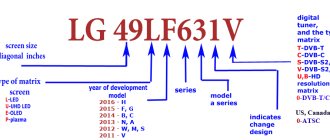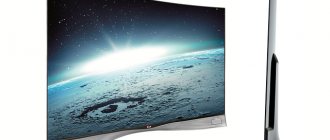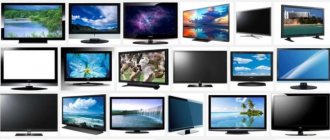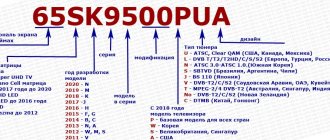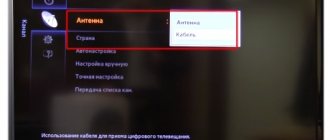Marking differences
The labeling of Samsung TVs differs depending on the year of manufacture of the model, due to technological improvements. TV models before 2021 had a distinctive type of marking, let’s look at the example of Samsung UE75K9000AB.
- U - TV display type, in this case LED;
- E—Region of application, Europe;
- 75 — Diagonal in inches;
- K - Year of release of the gadget, 2016;
- 9 - series number, the following zeros are intended for developers and carry information about the design;
- AB - tuner type.
However, since 2021, some changes have appeared in the labeling of televisions, for example, the series number may appear in three characters. If we look at each of them separately, the first means the series number, the second modification, and the third means that the TV supports 4K resolution.
Another change concerns the presence of an HDMI port: if there is an A symbol, then there is no port, if B, then it is installed. The marking is completed using the tuner value and destination country. Detailed description of Qled TV using the example of Samsung QE65Q90RBUXRU:
- Q - Qled display;
- E - for Europe;
- 65 – screen size 65 inches;
- Q9 - series number;
- 0 - modification number, judging by one symbol, model 4K;
- R - 2021 release;
- B — presence of an HDMI port;
- U is the tuner value;
- XRU - TV assembled for Russia.
conclusions
The most important parameters that can be found from the labeling are the year of manufacture and the series number.
The main technical characteristics that distinguish one series from another are:
- Availability of ports (USB, HDMI, etc.);
- Image enhancement technologies (increasing frame rate, better color reproduction, etc.). For example: Wide Color Enhancer Plus, Clean View, Clear Motion Rate 100, 400, 600;
- Availability of a Wi-Fi module, LAN port for connecting to the Internet;
- Availability of a tuner, for example, for receiving digital television. It can be DVB-T2 or DVB-T;
- Screen resolution: HD Ready, Full HD, Ultra HD;
- Frame rate, the frequency of the matrix itself;
- Availability of 3D functions, Smart TV, voice or gesture control.
There is also surround sound, a browser, the number of cores in the processor, the thickness of the case, etc. Some functions will be important to you, while others can be neglected. Pay attention only to what is really important to you so as not to overpay for the purchase.
If earlier, when choosing a TV, special attention was paid to the picture tube, today the determining indicator of performance is the type of matrix. The consumer properties of modern TV equipment depend on it. Among the main parameters are:
- Life time.
- Image quality.
- Maintainability.
Therefore, when choosing a TV, you need to know the advantages and disadvantages of all existing matrix systems.
Display and diagonal
After the brand name in symbol marking, the screen manufacturing technology comes first. For the period of 2021, 2 types of display are most often found:
- U - LED with backlighting liquid crystal LEDs;
- Q - QLED TV using quantum dots.
Currently discontinued display types:
- K - OLED with a matrix of organic light-emitting diodes;
- P - plasma;
- L—matrix illumination with fluorescent lamps;
- C - kinescope.
The second character in the marking value is used for the region of display production:
- E - Europe;
- A - Asia, Africa, Australia;
- N - Korea, North and South America;
- S - Iran.
The next 2 digits after the display type indicate its diagonal. Samsung's most popular models are considered to be television receivers with a diagonal of 32 to 65 inches.
Features and Benefits
Depending on the type of matrix, the image displayed on the screen has its own characteristics. Sometimes they are visible even to the naked eye, and in some cases, to notice the differences you need to pay attention to the display in different lighting or from different viewing angles. Depending on the type of matrix, screens may have an anti-reflective surface, and the effectiveness of their operation is determined by the arrangement, combination and principles of movement of the crystals. In the case of an LED matrix, the quality of the display determines the lifespan of the diodes. The color and overall lifespan of the screen depends on this.
The design of modern televisions is a case with a metal frame, in which connecting wires connected to the matrix are fixed. In addition, a light source is installed in LCD TVs as a backlight. Lighting used to come from mercury discharge lamps, but today most new displays use
LED backlight - LED. Therefore, many manufacturers claim that their TVs are created using LED technology. But this is far from the truth, because the matrix was and remains LCD, that is, LCD. To understand which TV design is better today, and to understand the disadvantages and advantages of displays, you need to know the features of various matrices.
Twisted Nematic (TN)
The first plasma TVs were introduced to world markets in the mid-90s by Fujitsu. The TN matrix, in which the crystals are twisted in a spiral, allowed her to do this. Depending on the tension, they may curl more or, on the contrary, straighten.
Thus, the angle of rotation of the crystals changes and, accordingly, the degree of transparency. Due to this, the color of each pixel changes. At the moment, such matrices are not produced, because back in 1996 a more advanced design appeared.
TN+Film
The main disadvantage of TN matrices was the small viewing angle. By using an additional diffuser layer, the so-called Film, the developers from Fujitsu managed to increase the viewing angle to 150 degrees. For the end of the last century, this was a real breakthrough in television technology. The main advantage of such matrices, in addition to the low price, is considered to be the high speed of response to signal changes.
Year of issue
Samsung uses a set of letters to indicate the year of manufacture. Let's look at what combinations of symbols Samsung uses to indicate the year of manufacture of the television receiver:
- 2019 - RU/R/Q*R;
- 2018 - NU/N/Q*N;
- 2017 - Q/MU/M;
- 2016 - KS/KU;
- 2015 - JS/JU;
- 2014 - HU/H;
- 2013 - F;
- 2012 - E;
- 2011 - D;
- 2010 - C;
- 2009 - B;
- 2008 - A.
As you can see, the symbol R is used for new products for 2021. In addition, additional Q*R values can be seen in the marking to emphasize the QLED model. However, the symbol R can also denote LCD TV models. During the 2015/16 period, additional symbols were used to indicate the year of manufacture, but applied to certain brands:
- S – TVs under the “SUHD” brand;
- U – ultra-high resolution 4K UHD screen.
If the user notices a TV receiver series on the marking after the year of manufacture, then we are talking about an LED HDTV with Full HD or HD Ready resolution.
Criteria for choosing a Samsung TV
Samsung brand TVs are among those products whose quality you can be sure of. Purchasing any model of this brand allows you to get equipment that will not create problems for its owners.
Among the huge number of models produced by the Korean giant, there are TVs that differ in technical characteristics and capabilities. To buy a model that best meets your stated needs, you need to evaluate the range according to a number of criteria.
Full HD or 4K?
Both technologies provide high-quality and clear images, but differ in screen resolution.
The following resolution options are found on Samsung TVs:
- 1920x1080 (Full HD)
- allows you to create a clear, contrasty and well-detailed picture that surpasses the quality of the image on monitors with a resolution of 1366x768 pixels (HD Ready). - 3840x2160 4K (Ultra HD)
- this resolution provides an almost perfect image, even better than the previous one.
There was a time when owners of TVs that supported the 4K Ultra HD format were faced with a shortage of content. But nowadays 4K is becoming increasingly popular, and the Full HD format is slowly but surely losing relevance.
Regular or curved screen?
All televisions produced until recent times had a flat screen - this option is familiar to every person who watches television. Models with curved screens are not yet common, and they were one of the first to produce such TVs with 4K Ultra HD resolution.
Advantages of curved screens:
- provide greater immersion and presence;
- good for watching 3D content;
- stylish appearance.
Minuses:
- due to the special geometry, glare is created over a much larger area than on flat screens;
- the viewing angle decreases - you need to look only from the comfort zone, which is 35-40°;
- models with diagonals less than 70 inches have to be viewed at close range, otherwise their image will be no different from their flat-screen counterparts;
- higher cost.
It makes sense to buy TVs with a curved screen for people who watch them alone, in a dimly lit room, like to play on a console, and have extra money. In all other cases, preference should be given to conventional flat screens.
Other screen characteristics
When choosing a TV of any brand, you need to pay attention to the following parameters:
- Diagonal.
It is selected taking into account the size of the room. Small TVs are used in the kitchen, and models with large diagonals are chosen for ordinary rooms - they provide a good immersion effect. The larger the diagonal, the more realistic the image will be. - Update frequency.
There are models in which frame changes occur at a low frequency - 50 Hz, and at a high frequency - 120 Hz. In models with frequencies above 100 Hz there is practically no difference in picture quality. Therefore, there is little point in chasing a high refresh rate - in models at 100 and 200 Hz, the image for the average viewer is no different.
Smart TV technology
Thanks to this technology, the TV becomes, in essence, a large tablet. This option is good for those who are used to using the Internet and prefer to independently select the content to watch.
Smart TV allows televisions to implement the same functions as smartphones, laptops, tablets - gadgets that operate on the Internet.
Despite the opportunities available to owners of TVs with Smart TV, many consumers prefer regular models, to which they later purchase special set-top boxes. There is also a certain percentage of users for whom watching TV channels is enough.
Cons of Smart TV:
- TVs do not play all video and audio file formats, and it is not possible to install some codecs;
- Controlling the remote control during games is inconvenient;
- not all games are suitable for Smart TV;
- performance may not be enough due to lack of power;
- Smart TVs are more expensive.
Models with Smart TV are suitable for those users who like to watch videos online and surf the web.
How many tuners?
Each TV has built-in tuners. They are needed to decode digital information streams and convert them into a picture. As a rule, one decoder (DVB-T / C/S) is enough to receive most broadcast formats. And analogue broadcasting is no longer relevant, so tuners for it (PAL/SECAM) are not required.
The best Samsung models have two digital tuners, so they can implement convenient picture-in-picture (PiP) functionality.
Response time
This parameter is measured in milliseconds and indicates the time it takes for the pixels to change brightness. The faster the response time, the clearer the pictures. At higher values, the image turns out blurry. In modern TVs, the response time should not be more than 8 ms.
HDR support
The implementation of this technology allows you to expand the boundaries of the dynamic range, which has a positive effect on contrast and color reproduction. This effect is achieved not by increasing the number of pixels, but by making them more efficient.
The technology of HDR TVs is more complex and expensive, which is why they cost more.
LCD Screen Technologies
Samsung TVs are distinguished by the type of technology implemented in their screens:
- OLED
- displays based on organic light-emitting diodes. This is an innovative technology based on the use of organic semiconductor materials to produce light. - QLEDs
are quantum dot light emitting diodes. In this technology, unlike OLED, LEDs are used to create the backlight of the matrix, creating white light. Essentially, QLED is an advanced liquid crystal display. - Crystal UHD
is the marketing name for models with LCD displays. They have ordinary matrices made using standard technology without quantum dots. Previously, such models made up Samsung's Premium TV series. Now Crystal UHD TVs represent series 6, 7 and 8. - MicroLED
is a new generation of flat screen technology. It is based on arrays of microscopic LEDs that form the pixel elements. This type of emissive screen is energy efficient and has similar characteristics to OLED displays.
Samsung also produces indoor TVs. They can be folded, rolled up, and disguised as interior items.
Series
Next, the user can decipher the series and subseries of the television receiver in the marking. The designation uses 3 symbols, each with its own meaning:
- The first digit indicates the series; a digital character set from 4 to 9 is used. And the higher the series value, the more they differ in the set of modern technologies and functions;
- The second means podcast series. Experts say that Samsung uses this data to indicate technical characteristics. There are no comments from the manufacturer regarding the meaning of the second digit of the series;
- The third digit indicates model design data.
How to find out the type of matrix in your TV
In order to understand what requirements must be placed on the quality of the image on the screen, it is necessary to determine what type it belongs to. Moreover, in the age of computer technology, this is extremely easy to do - enter the TV model into a search engine, and the World Wide Web will provide information on the technical characteristics in full.
If you don’t have the Internet at hand, then carefully study the data on the TV model; the types of matrices are also indicated there. Many manufacturers encrypt technical specification information in the serial numbers of their products. Therefore, if among the numbers you see a combination of letters - TN, TFT, IPS or other familiar abbreviations, then know that this is the name of the TV matrix.
You can also determine which playback technology is used by its characteristic features:
- To identify TN, check the contrast, contrast, and color gamut on the screen. If the quality indicators have decreased, then you have a TV with TN technology.
- Loss of color shades when looking at the right angle for a long time indicates MVA/PVA.
- A purple tint when looking at a screen with a black image at an angle indicates IPS.
When purchasing a TV, check all the information that the seller provides you.
IMPORTANT. Remember that the seller’s goal is to sell any product, and the buyer needs to buy the desired product at the lowest possible price.
The popular brand Samsung provides consumers with a wide range of products, which includes various household appliances and electronics. Samsung TV receivers are widely popular, they have excellent characteristics and allow you to plunge into the virtual world with all realism. The company's calling card is QLED TV devices, which are distinguished by high image quality, stunning detail and advanced functionality. The company tries to cover all niches, presenting budget, mid-range and premium models. In order to figure out which TV is what, let’s take a closer look at the labeling of Samsung TVs.
Tuner and destination country
The fourth value applies to the type and type of tuner. For example, the number 7 means a DVB-T2 tuner, and 0 deciphers the presence of a DVB-T tuner. This was used until 2013, and then numbers were replaced by letters, the latter meaning implied by the design of the device. The new decryption has the following meaning:
- AW (W) - DVB-T/C tuner;
- AB (B,AU or U) - DVB-T2/C/S2 tuner;
- AK (K) - DVB-T2/C tuner;
- AT (T) - two tuners 2 x DVB-T2/C/S2;
- SB - DVB-T2/C/S2 tuner;
- SS - DVB-T/C/S2 tuner;
- ST - two tuners 2 x DVB-T2/C/S2;
- SL - two tuners 2 x DVB-T/C/S2;
- AF (BF) - DTV Tuner/Digital Cable Tuner/Analog Tuner;
- DK - DVB-T2/C;
- AR (DR) - DTV Tuner/Analog Tuner.
Further, one or two letters may additionally appear in the tuner value. According to the manufacturer, these values are used for developers and do not carry specific information. At the end of the LG TV model, 3 symbols are used to decipher the region of application.
What types of matrices are used on modern TVs
Conventionally, all modern screens can be divided into two types:
- Liquid crystal displays (LCD) or in English – liqu > –>
But, in fact, the variety of matrices does not end there, because almost every manufacturer of monitors and television equipment is improving its products. And today, practically the only way to improve image quality is to make changes to the operation of the matrix. Therefore, every famous brand that produces displays and televisions has licensed matrices of its own design with an original name.
Continent
The second letter indicates the distribution area (for whom it is made):
- E – Europe;
- A - Asia, Africa, Australia;
- S – Iran;
- N - Korea, North and South America.
Screen size
Next in the model designation there are two numbers that indicate the size of the screen diagonal in inches (1 inch = 2.54 cm).
TV receivers are usually produced with screens from 32 inches to 65 inches, the most popular among users. There are also larger screens, but these are for larger rooms and most buyers do not choose them.
Decoding the model serial number
Product information is displayed not only in the labeling, but also in the serial number of each specific model. Using the serial number, you can find out in which country the TV was assembled, in what year and in what month, as well as the serial number, which is required when ordering new components or when carrying out repair work. You can find the serial number on the identification tag located on the back of the device.
The series number of Samsung TVs is also marked on the factory box and in the service book.
The serial number looks like this:
Screen view
The first letter indicates the screen manufacturing technology:
- U - illumination of the LCD matrix with LEDs (LED - Light-Emitting diode);
- Q – QLED, LCD matrix using quantum dots for backlighting, Quantum dot enhancement film (QDEF);
All modern Samsung TV models use liquid crystal matrices (LCD) as a display; the backlight of the matrix and the quality of the matrix itself differ. That's why there are regular U models and premium Q TVs.
Not released today:
- K - matrices of organic light-emitting diodes (OLED - Organic Light-Emitting Diode);
- P - plasma screen (PDP - Plasma Display Panel), discontinued in 2014;
- L — matrix illumination with fluorescent lamps (CCFL — Cold Cathode Fluorescent Lamp), not available since 2013;
- C - kinescope (CRT - Cathode Ray Tube), not produced today.
Screen types include shape; there are flat and curved displays. Already in 2021, only one series comes with a curved display, and before that there were more models with such a screen. Until 2018, the following letters were used in markings:
- F – flat screen (flat);
- C – curved screen (curved);



